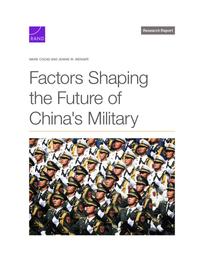Factors Shaping the Future of China's Military
ResearchPublished Jan 30, 2025
In this report, the authors consider how China's demographic changes will affect the People's Liberation Army (PLA) and China's broader society. They consider factors that influence military eligibility, compare China's youth population and population projections with those of the United States, and consider how other relevant factors are likely to influence the PLA's ability to recruit and to transform its military into a more modern force.
ResearchPublished Jan 30, 2025

China is experiencing rapid demographic change as young people are making up an ever-smaller share of the population. At the same time, China is seeking to modernize the People's Liberation Army (PLA). These two topics generally have been considered separately to date.
In this report, the authors place China's current population dynamics in context to consider how demographic changes will affect the PLA and China's broader society and to improve understanding of China's military strategy and of the choices China will likely face in the near term. First, the authors discuss China's current and past fertility rates, comparing trends in China with those in other countries. Next, they document China's age distribution and compare it with that of the United States. They discuss other specific health- and education-related trends that will influence PLA recruiting, present information about China's past and its likely future economic growth rates, and analyze the implications for the PLA and the country as a whole. Finally, the authors discuss the PLA's aims and the ways in which demographic and other trends may influence its capacity to achieve its goals.
The authors' analysis reveals that China's demographic trends do not portend a crisis for the PLA. However, China's economic and social environment will likely limit the PLA's ability to build the type of military that Chairman of the Central Military Commission Xi Jinping envisions. If the PLA cannot access the types of recruits it needs, it may be forced to rethink its goals and assumptions about modernization.
This research was prepared for the Office of the Secretary of Defense and conducted within the Personnel, Readiness, and Health Program of the RAND National Security Research Division.
This publication is part of the RAND research report series. Research reports present research findings and objective analysis that address the challenges facing the public and private sectors. All RAND research reports undergo rigorous peer review to ensure high standards for research quality and objectivity.
This document and trademark(s) contained herein are protected by law. This representation of RAND intellectual property is provided for noncommercial use only. Unauthorized posting of this publication online is prohibited; linking directly to this product page is encouraged. Permission is required from RAND to reproduce, or reuse in another form, any of its research documents for commercial purposes. For information on reprint and reuse permissions, please visit www.rand.org/pubs/permissions.
RAND is a nonprofit institution that helps improve policy and decisionmaking through research and analysis. RAND's publications do not necessarily reflect the opinions of its research clients and sponsors.